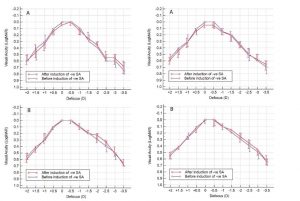ABSTRACT
Purpose:
To assess the effect of change in ocular spherical aberration (SA) with adaptive optics on visual acuity (VA) at different defocus after implantation of extended depth-of-focus (EDOF) and enhanced monofocal intraocular lenses (IOLs).
Settings:
Narayana Nethralaya Eye Hospital, Bangalore, India.
Design:
Prospective, longitudinal, observational.
Methods:
80 eyes (40 patients) that had cataract surgery were included in the study. 40 eyes were implanted with Eyhance EDOF IOLs and the remaining with Vivity EDOF IOLs. Baseline ocular aberrations were measured with a visual adaptive optics aberrometer, then the optimal SA was determined by increasing it in steps of −0.01 μm up to −0.1 μm until the maximum improvement in near distance VA was observed for a given eye. Then the defocus curve for each eye was measured after modifying the ocular SA by magnitude equal to optimal SA.
Results:
Most of the eyes accepted a negative induced SA of −0.05 μm (Eyhance group: 67.6%; Vivity group, 45.2%). In the Eyhance group (dominant eyes), VA improved at −2 diopters (D) (P < .02) only and degraded at 0 D, +0.5 D, and +1 D defocus (P < .05). In the Vivity group, the VA remained unchanged at all defocus (P > .05). In the Eyhance group (nondominant eyes), VA improved at −3.5 D defocus only and degraded at +1.5 D and +2 D defocus (P < .05). In the Vivity group, VA improved at −2.5 D defocus (P < .05) only.
Conclusions:
A negative induced SA of −0.05 μm in implanted eyes was optimal for a slight improvement in distance-corrected near and intermediate VA without any significant decrease in baseline distance-corrected VA.


